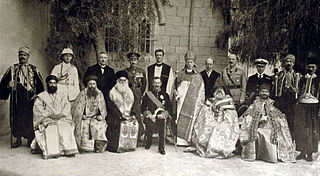Related Research Articles
Dionysius I Telmaharoyo, also known as Dionysius of Tel Mahre, was the Patriarch of Antioch, and head of the Syriac Orthodox Church from 818 until his death in 845.
Jacob of Edessa was Bishop of Edessa and prominent Christian writer in Classical Syriac language, also known as one of earliest Syriac grammarians. In various works, he treated theological, liturgical, canonical, philosophical and historical subjects, and contributed significantly to scholarly and literary development of Syriac Christianity. He is considered to be one of the most important scholars of the Christian-Aramean tradition.
John III of the Sedre was the Patriarch of Antioch and head of the Syriac Orthodox Church from 631 until his death in 648. He is commemorated as a saint by the Syriac Orthodox Church, and his feast day is 14 December.
Athanasius II Baldoyo, also known as Athanasius of Balad, and Athanasius of Nisibis, was the Patriarch of Antioch and head of the Syriac Orthodox Church from 684 until his death in 687.
John X bar Shushan was the Patriarch of Antioch, and head of the Syriac Orthodox Church, from 1063/1064 until his death in 1072/1073.
Ignatius Isaac II was the Patriarch of Antioch and head of the Syriac Orthodox Church from 1709 until his resignation in 1723.
Ignatius Jacob I, also known as Jacob al-Khuri or Jacob of al-Nabk, was the Patriarch of Antioch and head of the Syriac Orthodox Church from 1510/1512 until his death in 1517/1519.
Athanasius I Gammolo was the Patriarch of Antioch and head of the Syriac Orthodox Church from 594/595 or 603 until his death in 631. He is commemorated as a saint by the Syriac Orthodox Church in the Martyrology of Rabban Sliba, and his feast day is 3 January.
Julian I was the Patriarch of Antioch and head of the Syriac Orthodox Church from 591 until his death in 594/595. He is commemorated as a saint by the Syriac Orthodox Church.
Athanasius IV Salhoyo was the Patriarch of Antioch and head of the Syriac Orthodox Church from 986/987 until his death in 1002/1003.
Ignatius II was the Patriarch of Antioch and head of the Syriac Orthodox Church from 878 until his death in 883.
Theodosius Romanus was the Patriarch of Antioch and head of the Syriac Orthodox Church from 887 until his death in 896.
Dionysius II was the Patriarch of Antioch and head of the Syriac Orthodox Church from 896/897 until his death in 908/909.
Ahudemmeh was the Grand Metropolitan of the East and head of the Syriac Orthodox Church of the East from 559 until his execution in 575. He was known as the Apostle of the Arabs, and is commemorated as a saint by the Syriac Orthodox Church.
Ignatius George II was the Patriarch of Antioch and head of the Syriac Orthodox Church from 1687 until his death in 1708.
Qenneshre was a large West Syriac monastery between the 6th and 13th centuries. It was a centre for the study of ancient Greek literature and the Greek Fathers, and through its Syriac translations it transmitted Greek works to the Islamic world. It was "the most important intellectual centre of the Syriac Orthodox ... from the 6th to the early 9th century", when it was sacked and went into decline.
The Chronicle of Pseudo-Joshua the Stylite is an anonymous Syriac history of the period 494–506 AD. Its actual title as given in the manuscript is A Historical Narrative of the Period of Distress Which Occurred in Edessa, Amid and All Mesopotamia. It is divided between two distressful events that occurred in Edessa and the surrounding region: an outbreak of plague, locusts and famine from 494 to 502 and the Roman–Persian war of 502–506. It is the earliest surviving work of Syriac historiography and provides the most detailed account of the Roman–Persian war. It was written near in time to the events it describes and is thus of the highest historical value.

In the Syriac Orthodox Church, the Archbishop of Jerusalem today bears the additional title of Patriarchal Vicar of the Holy Land and Jordan. There was also a deputy metropolitan bishop of Jerusalem from the mid-18th century to the office's abolition in 1858, who resided at the monastery of Saint Ananias, then the headquarters of the Syriac Orthodox Patriarchate of Antioch, and was responsible for the collection of donations for the diocese.
George was the Syriac Orthodox bishop of the Arabs around Aleppo and the upper Euphrates from 686 or 687 until his death. A polymath steeped in ancient Greek philosophy, his writings are an important source for Syriac history and theology.
References
- 1 2 3 4 5 6 7 8 9 10 Van Rompay 2018.
- 1 2 3 4 5 6 7 8 Suermann 2008.
- 1 2 3 4 Tannous 2018.
- 1 2 Hoyland 1997, p. 390.
- ↑ Palmer 1993, p. 36.
- ↑ Barsoum 2003, p. 392.
- ↑ Hoyland 1997, pp. 516–517.